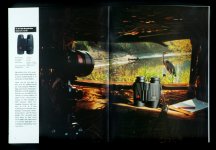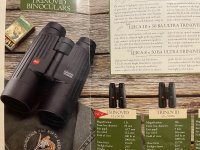I'm going to take a contrary stance, now that I have an 8x32 BA in my possession.
For the record, I also have these binoculars in house at the moment: an Ultravid 8x32 HD, an Ultravid 7x42 HD, a Nikon EDG 8x42, and an Opticron Traveler 8x32 ED. So pretty stiff, much more modern competition.
My hot take: the BA is not a sweet spot, it's just an older, crapper, heavier Ultravid. Unless you're a Leica fan who wants to own one for personal reasons (nostalgia, mystique, etc), a "normal" birder looking to plop down $600-700 for a premium 8x32 would be much happier spending that money on a more modern 8x32 like the Zeiss Conquest HD or Meopta Meostar, both of which are IMO far superior and sell for the same (or less!) than the BA/BN do on the used market.
Examining the 8x32 BA vs the 8x32 UVHD, it's apparent these are essentially the same binocular. The interior design and construction appears practically identical, the ocular is the exact same size, the FOV and distortion profile is basically the same. The "character" or "personality" of the view is the same, they both appear close enough to equal in terms of sweet spot size, aberration control, sharpness, curvature, even the CA you have to look hard to see that the UVHD is a bit better. Which makes sense, because the consensus is that the Ultravid is just an evolution of the Trinovid BA/BN -- same basic optical formula with gradual improvements in glass and coatings over time, wrapped in a lighter, slimmer, more modern skin.
But several decades of advancement in glass quality, coatings, engineering, materials.... it adds up. Time moved on, and the Trinovid is now a dated design. The UV does nothing worse, and in several key respects it's markedly superior. The UV is lighter and sleeker, brighter and clearer, with no downside (other than cost). Simply a much better, more modern, more refined version of the same thing.
I also believe most of the BA/BN reputation for "ruggedness" vs the Ultravid is bias based on the increased size/weight. Under the skin it's mostly the same thing. Either one is likely to outlive you, and both are built to extremely high standards.
And the reduction in weight and chunk is not minor. My 7x42 UVHD is only an inch longer, and ~100g heavier, than the 8x32 BA. And it feels slimmer in the hand because of the smooth, tapered shape. And it absolutely obliterates the 8x32 BA optically in all respects.
Even taking out the magnification / exit pupil variable, comparing the 8x32 BA to the 8x32 UVHD, when I switch to the UVHD it's like I took a pair of sunglasses off. The UVHD is MUCH brighter, MUCH more neutral, both of which result in MUCH better vividness, clarity, sparkle, pop, you name it. And it's ~100g lighter (i.e. a more meaningful >200g reduction vs the 7x42). And (for me at least) I much prefer the texture and feel of the Ultravid in the hand.
Perhaps the gap would be closer with a later model BN vs a BA, perhaps I'm just very biased towards superior color neutrality and brightness, but I was quite surprised at how much better the UVHD view was.
Now of course that's the case! you say... the Ultravid is newer and costs a lot more. But the BA/BN still sell for $600-800 used. I've seen Ultravid BR go in that price range. With a bit of patience a UVHD can be had in the $1000-1200 range (sometimes less). And, as I noted up top, if $$ is the motivating factor, a used Meostar or Conquest HD will be superior and probably cost you less money. Based on memory, I bet even the MiJ Vortex Viper 8x32 HD is superior overall, and (if you can find one) it would probably be 1/2 the price on the used market.
I totally understand why someone may enjoy for subjective, personal reasons -- for example ergonomic preferences, or nostalgia, aesthetics, or fuzzy warm feelings from using something "old school". Maybe you actually prefer a darker, less neutral image. That's fine, I've certainly bought things for far worse reasons. But other than your own personal fandom, I don't see any reason to seek one out anymore. Why would I want a heavier, crappier, older version of what I already have?
TL;DR + Summary:
- The Trinovid BA/BN is still competitive with premium binoculars in terms of resolution, contrast, etc., but in most respects it's a dated design and well behind more modern options that sell for the same or less on the used market (like Meopta Meostar or Zeiss Conquest HD).
- If there's a "sweet spot" there it's arguably a late model BN, not a BA, which will provide more modern coatings and therefore be brighter, with better color, and more durable (HDC advance).
- The Ultravid is a better, brighter, lighter, more refined version of the Trinovid BA/BN, and an Ultravid BR is not much more $$ on the used market. So if you're looking for a used Leica for birding (not as a collector's item), unless you just love the feel of that thick, ribbed, harder plasticky exterior, target an Ultravid instead.
- IMO - the true "sweet spot" for used is actually the ULTRAVID HD (not Plus). They are only marginally worse than the HD+ and sell for a lot less than HD+ on the used market, but aren't much more than the BR used. And, for the extra ~$200 you spend used vs a BR you get (1) the AquaDura coatings, (2) a bit more brightness and color neutrality, and, reportedly, (3) additional refinements in the focus mechanism to make it smoother and more reliable.










